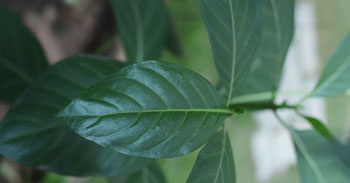KJC Medicinal Garden
Gantubhaarangi
Clerodendrum serratum
Order: Lamiales
Family: Verbenaceae
Genus: Clerodendrum
Species: C. serratum
Common Names: Bharangi, Blue-flowered Glory Tree
Native to Tropical and warm temperate regions like Africa, Southern Asia, Malaysia, forests of India and Sri Lanka.
Other plants of the same genus with medicinal properties
-
C. indicum
C. phlomidi
C. serratum var. amplexifolium
C. trichotomum
C. chinense
C. petasites
- Slightly woody shrub with blunt stems and branches. Small shrub (2-4 metre tall), annual or perennial
- Root: Mature root hard, woody, cylindrical; up to 5 cm thick; external surface light brown having elongated lenticels.
- Stem: quadrangular (four-angled).
- Bark: Thin and easily separated from a broad wood which shows marked medullary rays and concentric growth rings in a transversely cut surface; short fractures; acrid taste.
- Leaf: three at a node, opposite oblong or elliptic, serrate, alternate without stipules.
- Flower: pinkish white-blue, bisexual, zygomorphic, Corolla with a slender tube, lobe-5, spreading; stamens epipetalous (4 or 2 in number), anther 1 or 2-celled usually dehiscing longitudinally; disc persistent. Superior 2-celled ovary and each cell consists of 2 ovules.
- Fruit: Four lobed purple drupe.
- Seed: With or without endosperm.
Uses in Tradition systems of medicine
- Used in Ayurveda, Siddha and unani medicines
- Root is used in the treatment of asthma, cough and scrofulous affections.
- Used to treat fever and sinusitis.
- Juice of leaves is mixed with ghee as an application to herpetic outbreaks and pemphigus.
- Roots are claimed to be used in dyspepsia.
- Leaves serve as vermifuge and is a bitter tonic.
- The root is one of the ingredients of Brahata panchamool.
- The plant is considered as antitoxic, antiseptic, astringent and styptic.
- Breaks down mucus and acts as mucolytic
- Improves digestion strength
- Useful in worm infestation
- Useful in treating burning sensation
- Carbohydrates ( D-mannitol)
- Steroids
- Flavonoid
- Protein
Suggested Medicinal Properties
- Antimicrobial
- Anti-asthmatic
- Anti-carcinogenic
- Antioxidant
- Anti-pyretic
- Wound healing activity
- Gastro protective activity
- Anti-inflammatory
- Anti-allergic
- Anti-hypertensive
- Hypoglycaemic
- Hepatoprotective
- Neuroprotective
- Anti-nociceptive
Active Phytochemicals
1. Saponins
2. D – mannitol

3. Stigmasterol (2,3,4,5,6,6a,7,8,8a,,10,11,12,13,14b-tetradecahydro-1H-picene-4a-carboxylic acid)
6. Clerodone (3β- hydroxyl- lupan 12-one)
7. Β-sitosterol
8. Arabinose
9. Catchin
10. α-spinosterol
11. Luteoline
12. Ethycholesta – 5, 24 25- trine 3β-o-hispidulin
13. Hispidulin

14.Cleroflavone
15. Apigenin

16. 7-hydroxy flavanone
17. scutellareinand pectolinarigenin
18. serratagenic acid
19. acteoside
20. indolizino
References
Jagruti J. P, Sanjeev R. A, Niyati S. A. Clerodendrum serratum (L.) Moon. – A review on traditional uses, phytochemistry and pharmacological activities, Journal of Ethnopharmacology, 154, 2 (2014): 268-285, ISSN 0378-8741, https://doi.org/10.1016/j.jep.2014.03.071.
Singh M.K, Khare G., Iyer S.K., Sharwan G. and Tripathi D. K. Journal of Applied Pharmaceutical Science. 02, 02 (2012): 11-15.

